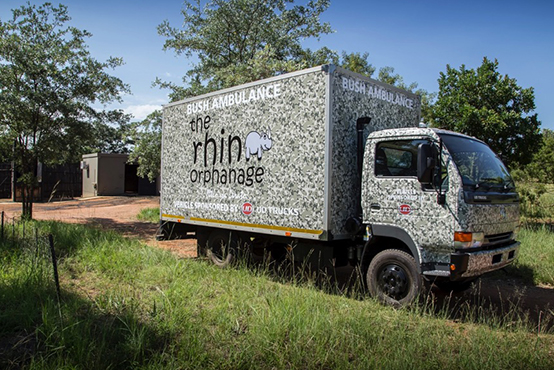UD Trucks contributes to rescuing rhinos in South Africa by donating the last UD40 truck to roll off the production line.
The very last UD40 to roll off the production line has been given a rather unusual role. Donated as a bush ambulance, this last UD40 is transporting baby rhinos for the Legend Rhino Orphanage in South Africa. As a rhino horn-poaching epidemic sweeps across the African continent, orphaned rhinos calves face certain death if they aren’t given a helping hand.

The calves now have a safe harbor to grow up at the legend Rhino Orphanage. And one day they will be released back to the wild. The actual location is kept a secret, because poachers are still a threat.
Dire situation
A while ago, CNN reported that the world’s last male northern white rhino had been put under 24-hour armed guard in a nature reserve in Kenya. His horn has been cut off to protect him from poachers, but with rhino horn more valuable per gram than cocaine, even the stump could attract poachers. It sells for upwards of $100,000 a kilogram, and a large horn can weigh 3kg.
In South Africa, rhinos are being wiped out so quickly that the Department of Environmental Affairs now refuses to report the statistics regularly. It last updated the figures in January 2015, with a death toll of 49 for the month. But already 666 rhinos have been slaughtered last year in South Africa alone, according to Outraged South African Citizens Against Poaching (OSCAP). The total for 2014 was 1,215, so despite government promises to crack down on poaching, the death toll is still rising.

Entry and exit bullet marks are clearly visible on Thani’s neck. She was shot by poachers and then attacked by lions who bit a piece of her ear off and left scratch wounds all over her body
When poachers kill a rhino there is more than one casualty, because a calf whose mother is slaughtered has little chance of survival. Sometimes poachers kill the calf too, because horn attracts a high price, making even a tiny horn a target. If the calf escapes, it is frightened, often injured and destined to die in the bush, killed by lions or other predators, or to starve because they are dependent on mother’s milk for three years.
The bush ambulance for rescue
Rescuing the orphaned calves is one of the essential measures for preserving the species. The orphanage relies entirely on donations and sponsorships, and is a cause that touched the hearts of the UD Truck in South Africa. When the last of the UD40 model was manufactured in the earlier 2015, the vehicle was donated to the orphanage for use as a bush ambulance.

For this important mission, the body of the truck was customized to look after its young but extremely heavy and frightened passengers. A lift was added to hoist a rhino in a crate up into the vehicle. Air conditioning was fitted, and range of veterinary equipment was installed, along with a seat so a vet can sit with the calf and start medical treatment immediately.
The rescue and release program run by the orphanage is so successful that game reserves across South Africa now call for help whenever their rangers or anti-poaching teams find an orphaned calf. The carers immediately go to collect it in the bush ambulance.
“The truck is essential because rhinos are big and heavy animals, so it takes something substantial to move them around, whether it’s from the point of poaching to the orphanage or to release them into the wild,” says Pete Richardson, co-founder of the orphanage.
The UD40 model has a reputation for being dependable, versatile, tough and easy-to-maintain, making it perfect for game reserves that have dirt roads and are nowhere near a service depot.

“With the last UD40 rolling off the productions line, this legendary model is now extinct, so to speak, and we wanted to help the Rhino Orphanage prevent a living legend, the rhino, from going extinct as well in a very practical way,” said Rory Schulz, marketing director of UD Trucks Southern Africa. “We are proud that the ultimately dependable UD40 supports the Rhino Orphanage’s efforts in protecting rhinos for generations to come.”
Until 2015, there are about a dozen of rhinos have been released and all are doing well. One has even given birth to a calf of her own.

Collective effort
Every year, young adults come to the orphanage to help out and to learn. They become advocates on social media to raise money and to campaign for the cruel and illegal trade to end. No trading, no killing. To eventually stop the illegal poaching, to preserve the planet that we live in, it needs a collective effort from every one of us.
For details, to make a donation or to follow the progress of the orphanage, see www.facebook.com/TheRhinoOrphanage
